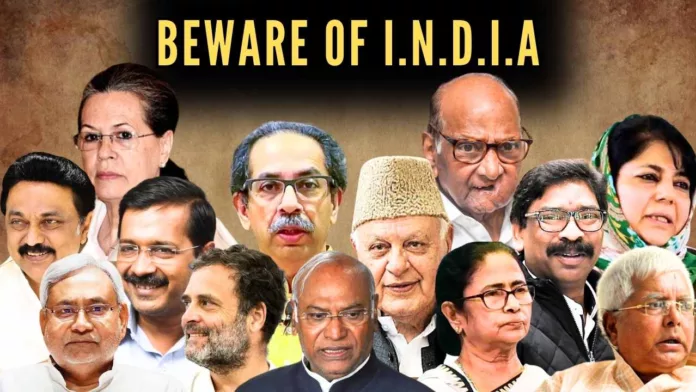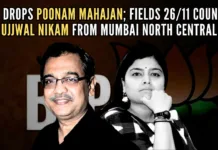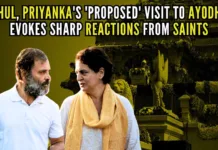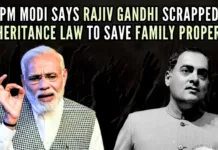
26 Opposition parties form ‘I.N.D.I.A’ alliance to challenge PM Modi & BJP in 2024 elections
On July 17-18, 2023, leaders of 26 Opposition parties, mostly from South India, including Dravida Munnetra Kazhagam (DMK), met at Bengaluru, under the banner of the London-founded Congress. Some other parties which took part in the meeting included Trinamool Congress (TMC), Janata Dal-United (JDU), Rashtriya Janata Dal (RJD), Samajwadi Party (SP), Aam Admi Party (AAP), CPI, CPIM, National Conference (NC) of Abdullahs, Peoples Democratic Party (PDP) of Mehbooba Mufti and Muslim League. They discussed ways and means for about eight hours and their stated objective is to defeat PM Narendra Modi and the BJP in the 2024 general elections.
On July 18, they held a press conference, which was addressed, among others, by AICC president and Leader of Opposition in Rajya Sabha, Mallikarjun Kharge, the disqualified MP and former AICC chief, Rahul Gandhi, WB Chief Minister, and TMC chief, Mamata Banerjee, and the owner of AAP and Delhi Chief Minister, Arvind Kejriwal.
Kharge announced the demise of the United Progressive Alliance (UPA) of which Sonia Gandhi was the chairperson and said that the Opposition parties had renamed UPA as I.N.D.I.A. (Indian National Developmental Inclusive Alliance). He also said that the “BJP was assaulting the character of the republic” and declared that the alliance was formed to “safeguard the idea of India as enshrined in the constitution”. “The main aim is to stand together to safeguard democracy and the Constitution,” Kharge said. Gandhi said, “The fight against BJP is a fight to ‘defend the idea of India, defend the voice’ of the Indian people”. Others who addressed the press conference made almost identical statements.
And, on July 21, Rajya Sabha member and leader of TMC, Derek O’Brien, among other things, wrote in his “I-N-D-I-A is a big idea”: “The leaders of the political parties who met earlier this week at the Bengaluru summit were not just looking for a name. They were looking for an idea. They were looking for a BIG IDEA. They came up with one. India. Indian National Developmental Inclusive Alliance. Add the tagline Jeetega Bharat or more and you have a blockbuster…”[1].
Composition of I.N.D.I.A
Even a cursory look at the composition of the outfit would be enough even for a naïve to draw a conclusion that it consists of those who never considered India a nation or those who considered the Indian nation a congregation of over 24 nationalities with each nationality having the right to secede or having the right to have a dispensation outside the constitutional organization of India. It would also help us draw a conclusion that the outfit is ultra-secular, or rabidly anti-Hindu, and that almost all the constituent units of the I.N.D.I.A. are an integral part of the “Bharat Tere Tukde Honge” gang. Not just this, it would also help us conclude that all of them are vehemently opposed to Uniform Civil Code (UCC), Citizenship Amendment Act (CAA), National Register of Citizens (NRC), National Population Register (NPR), Ram Mandir, to mention only a few, and give unflinching support to the 1991 Places of Worship Act which bars the Hindus from reclaiming their desecrated and occupied religious places as they existed before August 15, 1947. It is also not a secret that the constituents of I.N.D.I.A. extend their unqualified and fullest possible support to illegal aliens, including Bangladeshis and Rohingyas, leave no stone unturned to pit Hindus against Hindus and win over and appease and please Muslims and Christians, and relentlessly fight for the protection of minority rights to the majority Christian and Muslim communities in the Hindu-minority States and Union Territories, including J&K.
Compromising territorial integrity
What is their idea of India and what type of democracy and secularism do they vouch for and advocate? A few examples: The Congress helped the Muslim League create out of India Pakistan exclusively for Muslims in 1947 and, at the same time, allowed Muslims to stay put in leftover India to hurt the majority community and muddy Indian waters. Not content with this, the Congress allowed just-created Pakistan to annex J&K territories, now called PoJK and Gilgit-Baltistan, convert these areas 100 percent in just 14 months (Oct 1947-Dec 31, 1948) and cause Hindu-Muslim migration from these areas. Pakistan could do and achieve what the Mughals and Pathans failed to do and achieve in these areas during the barbarous medieval era.
Not content with what the Congress government did in 1947-1948 to compromise the territorial integrity of India, it enabled China to annex over 50,000 sq km area of J&K’s Ladakh in 1962. And defending the nation’s humiliating defeat in Rajya Sabha, PM Nehru said: “It is a territory where not even a blade of grass grows, about 17,000 feet high. Ladakh is a useless uninhabitable land. We did not even know where it was”. He made this statement during the debate on Aksai Chin. So perturbed was a member of Rajya Sabha, Mahavir Tyagi, that “pointing to his bald head,” he “angrily” said, “I am bald, does that mean I will abandon my head”[2].
Undermining sovereignty
The January 10, 1966 and July 2, 1972 Tashkent Agreement and Shimla Agreement, respectively, between the Congress government and Government of Pakistan; the July 16, 2009 PM Manmohan Singh’s Sharm-el-Sheikh (Egypt) statement on the margins of the NAM summit accepting involvement of India in Baluchistan; the April 24, 2010 report from Lahore that Manmohan Singh government and Government of Pakistan had almost devised a (unsettling) solution to the so-called Kashmir problem; the February 6, 2011 humiliating outcome of talks between Indian Foreign Secretary Nirupama Rao and her Pakistani counterpart Salman Bashir on the sidelines of the meeting of the Standing Committee of the South Asian Association of Regional Cooperation (SAARC) at Thimpu (Bhutan) and Rao’s positive statement on the negative outcome; the manner in which the UPA government allowed articulate, assertive and provocative Pakistan Foreign Minister Hina Rabbani Khar to meet the leadership of two factions of the All-Party Hurriyat Conference in Delhi on July 26, 2011; the February 7, 2012 report filed by news agencies which revealed that Manmohan Singh government had “planned to ease visa regulations for Pakistan nationals”; the manner in which the UPA government allowed Pakistan Foreign Secretary Jalil Abbas Jilani to meet eight Kashmiri separatists, including Syed Ali Shah Geelani and Mirwaiz Umar Farooq, on July 3, 2012 in Delhi and the manner in which it allowed a meeting between Pakistan Interior Minister Rehman Malik and Hurriyat Conference leadership at Pakistan High Commission on December 14, 2012 in New Delhi; the Defence Minister A K Antony’s Parliament statement that “August 6, 2013 attack on the forward post in the Poonch sector and the resultant brutal killing of our five soldiers was the handiwork of terrorists, and not of Pakistan”; the May 10, 2013 Salman Khurshid’s statement at Beijing that he “did not raise the issue of the Chinese intrusion into Ladakh with the Chinese Premier and his Chinese counterpart” and that “he would want to live in Beijing for some more days”; the September 26, 2013 talks between Manmohan Singh and his Pakistani counterpart Mian Nawaz Sharif on the margins of United Nations General Assembly and Foreign Minister Salman Khurshid statement in New York that “New Delhi and Islamabad will form a common platform to fight the scourge of terrorism”; the manner in which Manmohan Singh kept the nation in complete dark about his decision that “he shall meet with Mian Nawaz Sharif at New York on September 29, 2013”; the manner in which the Manmohan Singh government allowed a meeting between Sartaz Aziz, PM Mian Nawaz Sharif’s advisor on security and foreign relations, and Kashmiri separatists at Pakistan High Commission on November 10, 2013 in Delhi and the November 10, 2013 statement of Foreign Minister Salman Khurshid that “several foreign ministers are in the capital (New Delhi) for the meeting but the government has nothing to do with their private engagements (with Hurriyat leaders) during their stay in Delhi”; the manner in which Salman Khurshid on November 12, 2015 condoned all the Pakistani crimes, praised PM Nawaz Sharif, hailed Pakistan’s policy on scourge of terrorism and charged PM Narendra Modi with not “reciprocating the Pakistani goodwill gestures” calculated to forge a so-calling “lasting peace in South Asia” at the Karachi-based Jinnah Institute; and the manner in which former Congress minister Mani Shankar Aiyar on November 17, 2015 told a Pakistani anchor in Pakistan that if Kashmir was to be resolved, PM Narendra Modi had to be removed and the Congress’s rule had to be reestablished in Delhi should leave none in any doubt that the Congress/ UPA government again and again knelt and humiliated the nation by undermining national sovereignty.
Promoting fissiparous tendencies
The Congress and the ragtag ultra-secular UPA not only undermined Indian sovereignty and compromised the territorial integrity of the country, but they also missed no opportunity to promote fissiparous tendencies in Kashmir and weaken the Indian position in this highly strategic region. The transfer of state power from the Jammu Dogras to separatist of separatists and communalist of communalists Sheikh Abdullah of Kashmir immediately after the accession of J&K to the Indian Dominion on October 26, 1947; the adoption of Article 306A (Article 370) on October 17, 1949, to grant separate status to J&K on the ground that it was a Muslim-majority region and that, too, after ignoring the warning that “grant of special status to Kashmir on the score of religion would enable it to assume independence afterward”; the application of illegal Article 35A in J&K on May 14, 1954 w.e.f. May 14, 1944 to empower the Kashmiri Muslim leadership to declare all non-Kashmiris persona-non-grata in J&K; the June 14-July 24, 1952 negotiations at New Delhi between PM Nehru and the Sheikh on the political future/ status of J&K vis-a-via India; the 1975 Indira Gandhi and Sheikh Abdullah Accord under which the deflated Sheikh was reinstalled as executive head of J&K and under which the latter was empowered to review all the central laws and institutions introduced in the state after August 9, 1953; the 1986-87 Rajiv Gandhi- (votary of limited accession) Farooq Abdullah Accord; the installation of protagonist of self-rule and mouthpiece of Pakistan Mufti Sayeed as J&K chief Minister on November 2, 2002 under the divisive and unsettling “Common Minimum Programme” approved by Sonia Gandhi and signed between Manmohan Singh, the Mufti and others, including M Y Tarigami of the CPIM and Bhim Singh of the Panthers Party; and the formation of the NC-Congress coalition government in J&K under seditionist Omar Abdullah on January 5, 2009 and the unbridled freedom he enjoyed for full six years to attack the Indian institutions, including the institution of the army, challenge the accession of J&K and further widen the already rather wide gulf between J&K and the rest of the country and constitute only a few of several such instances which simply serve to prove that the Congress and the UPA left no stone unturned to drive the state away from the country’s mainstream.
Changing demography
Besides undermining national sovereignty and territorial integrity and promoting fissiparous tendencies, Congress and the UPA did all that they could change the demographic landscape of the country, particularly after the Indo-Pak War of 1971 and the establishment of Bangladesh as an independent and sovereign nation. The creation of Bangladesh resulted in the demographic invasion of India. Millions and millions of Bangladeshis entered several parts of the country, including West Bengal, Assam, Bihar, Delhi, and J&K. Not just this, the rise of the UPA under Sonia Gandhi and Sonia Gandhi-nominated PM Manmohan Singh helped Rohingyas to come to India on an unprecedented scale and settle in different parts of the country, including Jammu, Delhi, Haryana, Rajasthan, Andhra Pradesh, Telangana, and Kerala. In J&K, the Congress, the UPA, and Kashmiri chief ministers, including Omar Abdullah, settled almost one lakh Rohingyas at strategic locations in and around Jammu city and the Jammu province’s border district of Samba. These Bangladeshi and Rohingya aliens have not only endangered national security and changed the political dynamics in the states like West Bengal, Delhi, Bihar, Jharkhand, and Telangana but they have also been eating up India’s resources.
It is obvious that the results would be disastrous if the so-called I.N.D.I.A. recapture the state power. The already at-the-receiving-end-nation would do well to appreciate the ground realities as they exist in the country by defeating the game plan of I.N.D.I.A.
To say all this is not to suggest that the BJP and the NDA didn’t commit any mistakes. They did commit several mistakes. Some of them include the induction of Omar Abdullah into the A B Vajpayee’s Council of Ministers as MoS External Affairs; the 1999 PM Vajpayee’s Lahore bus naïve/ failed diplomacy; the manner in which Vajpayee announced a unilateral ceasefire in December 2000 and extended hand of friendship to Pakistan on May 1, 2003; the December 25, 2014 PM Narendra Modi’s mind-boggling Lahore visit; and the March 1, 2015 BJP-PDP agenda of subversion and abdication.
However, the silver lining is that Narendra Modi and HM Amit Shah did admit that they committed a grave blunder by forging an alliance with Mufti Sayeed and Mehbooba Mufti. That they tried to undo some of the past wrongs could be seen from the removal of Mehbooba Mufti from the Chief Minister’s chair on June 2018 and the abrogation of Articles 35A and 370 on August 5-6, 2019. That day, they also brought the separatists like Farooq Abdullah, Ghulam Nabi Azad, Omar Abdullah, and Mehbooba Mufti to the knees by dividing the state into two union territories – UT of J&K and UT of Ladakh. They have still to cover much ground both in J&K and the rest of the country and take a definite stand on UCC, CAA, NRC, NPR, Places of Worship Act, Bangladeshis, Rohingyas, Jammu province, and minority rights to majority Muslim and Christian communities.
Note:
1. Text in Blue points to additional data on the topic.
2. The views expressed here are those of the author and do not necessarily represent or reflect the views of PGurus.
Reference:
[1] Derek O’Brien writes: I-N-D-I-A is a big idea – Jul 21, 2023, The Indian Express
[2] Not a blade of grass grows there (Ladakh), we did not even know where it was, quipped Prime Minister Nehru – Jun 18, 2020, The News 21
PGurus is now on Telegram. Click here to join our channel and stay updated with all the latest news and views
For all the latest updates, download PGurus App.











Let me guess, the hyphens in I-N-D-I-A are a subliminal hint about breaking India?